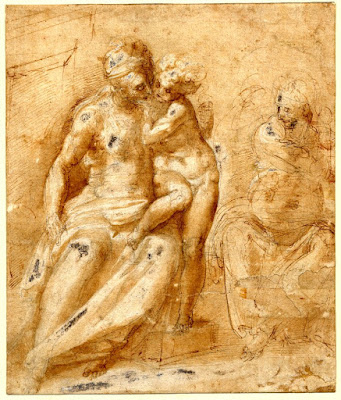 |
| Battista Franco Venus and Cupid ca. 1530-60 drawing British Museum |
 |
| Battista Franco Draped female figure seated on trophy ca. 1530-60 drawing British Museum |
 |
| Battista Franco Nude youth crouching ca. 1530-60 drawing British Museum |
"Battista Franco of Venice, having given his attention in his early childhood to design, went off at the age of twenty, as one who aimed at perfection in that art, to Rome, where, after he had devoted himself for some time with much study to design, and had seen the manner of various masters, he resolved that he would not study or seek to imitate any other works but the drawing, paintings, and sculptures of Michelangelo; wherefore, having set himself to make research, there remained no sketch, study, or even any thing copied by Michelangelo that he had not drawn. Wherefore no long time passed before he became one of the first draughtsmen who frequented the Chapel of Michelangelo, and, what was more, he would not for a time set himself to paint or to do any other thing but draw."
 |
| Battista Franco Sacrifice of Isaac ca. 1530-60 drawing British Museum |
 |
| Battista Franco Tarquin attacking Lucretia ca. 1536-41 drawing British Museum |
"These Florentine festivities finished, Battista set himself to draw with the greatest industry the statues of Michelangelo that are in the new Sacristy of S. Lorenzo, to which at that time all the painters and sculptors of Florence had flocked to draw and to work in relief; and among these Battista made no little proficience, but, nevertheless, it was recognized that he had committed an error in never consenting to draw from the life and to use colors, or to do anything but imitate statues and little else besides, which had given his manner a hardness and dryness that he was not able to shake off, nor could he prevent his works from having a hard and angular quality, as may be seen from a canvas in which he depicted with much pains and labor the Roman Lucretia violated by Tarquinius."
 |
| Battista Franco St Jerome in penitence ca. 1530-60 drawing British Museum |
 |
| Battista Franco Virgin and Child ca. 1530-60 drawing British Museum |
 |
| Battista Franco Gods of Olympus ca. 1530-60 drawing British Museum from the collection of Everhard Jabach, Paris |
 |
| Battista Franco Mother of St James and St John addressing Christ and requesting principal places in heaven for her sons ca. 1536-41 drawing British Museum from the collection of Everhard Jabach, Paris |
"Battista then returned to Rome, at the very time when the Judgment of Michelangelo had just been uncovered; and, being a zealous student of the manner and works of that master, he gazed at it very gladly, and in infinite admiration made drawings of it all. And then, having resolved to remain in Rome, at the commission of Cardinal Francesco Cornaro – who had rebuilt the palace that he occupied beside S. Pietro, which looks out on the portico in the direction of Camposanto – he painted over the stucco a loggia that looks towards the Piazza, making there a kind of grotesques all full of little scenes and figures; which work, executed with much labor and diligence, was held to be very beautiful."
 |
| Battista Franco Composition with six figures ca. 1530-60 drawing British Museum |
 |
| Battista Franco St John the Baptist in the Wilderness ca. 1530-60 engraving British Museum |
 |
| Battista Franco Six subjects after antique cameos ca. 1530-60 etching British Museum |
". . . Battista transferred himself by means of Bartolommeo Genga to the service of the Duke of Urbino, to paint a very large vaulting in the church and chapel attached to the Palace of Urbino. Having arrived there, he set himself straightway to make the designs according as the invention presented itself in the work, without giving it any further thought and without making any compartments. And so in imitation of the Judgment of Buonarroti, he depicted in a Heaven the Glory of the Saints, who are dispersed over that vaulting on certain clouds, with all the choirs of the Angels about the Madonna, who, having ascended into Heaven, is received by Christ, who is in the act of crowning her, while in various separate groups stand the Patriarchs, the Prophets, the Sibyls, the Apostles, the Martyrs, the Confessors, and the Virgins; which figures, in their different attitudes, reveal their rejoicing at the advent of that Glorious Virgin. This invention would certainly have given Battista a great opportunity to prove himself an able master, if he had chosen a better way, not only making himself well-practised in fresco-colors, but also proceeding with better order and judgment than he displayed in all his labor. But he used in this work the same methods as in all his others, for he made always the same figures, the same countenances, the same members, and the same draperies; besides which, the coloring was without any charm, and everything labored and executed with difficulty. When all was finished, therefore, it gave little satisfaction to Duke Guidobaldo, Genga, and all the others who were expecting great things form the master, equal to the beautiful design that he had shown them in the beginning; for in truth, in making beautiful designs Battista had no peer and could be called an able man."
– from the Life of Battista Franco, published in Giorgio Vasari's Lives of the Painters in 1568, translated by Gaston du C. de Vere and published in English in 1912
 |
| Battista Franco Frieze of human skulls 1560s etching British Museum |
 |
| Battista Franco Three airborne angels with jars ca. 1530-60 etching British Museum |